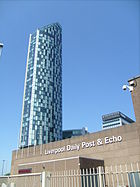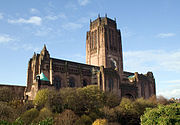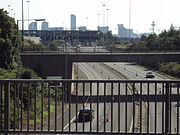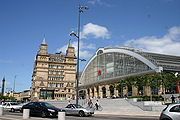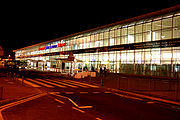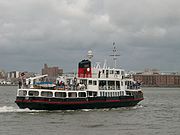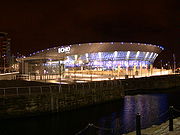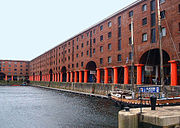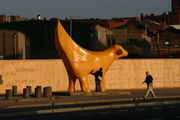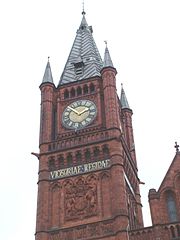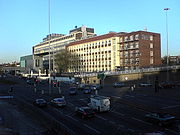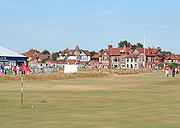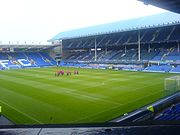
Liverpool
Background to the schools Wikipedia
This Wikipedia selection is available offline from SOS Children for distribution in the developing world. With SOS Children you can choose to sponsor children in over a hundred countries
| Liverpool | |||
|---|---|---|---|
| — Metropolitan borough & City — | |||
| Clockwise from the upper left: the Cavern Club, the Three Graces of the Pier Head (the Liver Building, Cunard Building and Port of Liverpool Building), the skyline of Liverpool's commercial district, the Albert Dock and St George's Hall | |||
|
|||
| Nickname(s): The Pool, The World In One City | |||
| Location within England | |||
| Coordinates: 53°24′N 2°59′W | |||
| Sovereign state | United Kingdom | ||
| Constituent country | England | ||
| Region | North West England | ||
| Ceremonial county | Merseyside | ||
| Admin HQ | Liverpool City Centre | ||
| Founded | 1207 | ||
| City Status | 1880 | ||
| Government | |||
| • Type | Metropolitan borough, City | ||
| • Governing body | Liverpool City Council | ||
| • Leadership: | Leader & Cabinet | ||
| • Executive: | Labour | ||
| • Leader of the City Council | Cllr Joe Anderson (Lab) | ||
| • MPs: | Steve Rotherham (Lab), Stephen Twigg (Lab), Louise Ellman (Lab), Luciana Berger (Lab), Maria Eagle (Lab) |
||
| Area | |||
| • Metropolitan borough & City | 43.18 sq mi (111.84 km2) | ||
| Elevation | 230 ft (70 m) | ||
| Population (2007 est / Urban=2006) | |||
| • Metropolitan borough & City | 465,700 ([[List of English districts by population|Ranked 9th]]) | ||
| • Density | 12,950/sq mi (5,001/km2) | ||
| • Urban | 816,900 | ||
| • Metro | 1,103,089 | ||
| • Ethnicity (June 2007 estimates) |
Ethnic groups
|
||
| Time zone | Greenwich Mean Time ( UTC+0) | ||
| • Summer ( DST) | British Summer Time ( UTC+1) | ||
| Postal Code | L postcode area | ||
| Area code(s) | 0151 | ||
| ISO 3166-2 | GB-LIV | ||
| ONS code | 00BY | ||
| OS grid reference | SJ3490 | ||
| NUTS 3 | UKD52 | ||
| Demonym | Scouser/Liverpudlian | ||
| Website | http://www.liverpool.gov.uk/ | ||
Liverpool (pron.: / ˈ l ɪ v ər p uː l /) is a city and metropolitan borough of Merseyside, England, along the eastern side of the Mersey Estuary. It was founded as a borough in 1207 and was granted city status in 1880. Liverpool is the fourth largest city in the United Kingdom (third largest in England) and has a population of 435,500, and lies at the centre of the wider Liverpool Urban Area, which has a population of 816,216.
Historically a part of Lancashire, the urbanisation and expansion of Liverpool were both largely brought about by the city's status as a major port. By the 18th century, trade from the West Indies, Ireland and mainland Europe coupled with close links with the Atlantic Slave Trade furthered the economic expansion of Liverpool. By the early 19th century, 40% of the world's trade passed through Liverpool's docks, contributing to Liverpool's rise as a major city.
Inhabitants of Liverpool are referred to as Liverpudlians but are also colloquially known as " Scousers", in reference to the local dish known as " scouse", a form of stew. The word " Scouse" has also become synonymous with the Liverpool accent and dialect. Liverpool's status as a port city has contributed to its diverse population, which, historically, were drawn from a wide range of peoples, cultures, and religions, particularly those from Ireland. The city is also home to the oldest Black African community in the country and the oldest Chinese community in Europe.
The popularity of The Beatles and the other groups from the Merseybeat era contributes to Liverpool's status as a tourist destination; tourism forms a significant part of the city's modern economy. The city celebrated its 800th anniversary in 2007, and it held the European Capital of Culture title together with Stavanger, Norway, in 2008.
Several areas of the city centre were granted World Heritage Site status by UNESCO in 2004. Referred to as the Liverpool Maritime Mercantile City, the site comprises six separate locations in the city including the Pier Head, Albert Dock and William Brown Street and includes many of the city's most famous landmarks.
History
King John's letters patent of 1207 announced the foundation of the borough of Liverpool, but by the middle of the 16th century the population was still only around 500. The original street plan of Liverpool is said to have been designed by King John near the same time it was granted a royal charter, making it a borough. The original seven streets were laid out in a H shape:
- Bank Street (now Water Street)
- Castle Street
- Chapel Street
- Dale Street
- Juggler Street (now High Street)
- Moor Street (now Tithebarn Street)
- Whiteacre Street (now Old Hall Street)
In the 17th century there was slow progress in trade and population growth. Battles for the town were waged during the English Civil War, including an eighteen-day siege in 1644. In 1699 Liverpool was made a parish by Act of Parliament, that same year its first slave ship, Liverpool Merchant, set sail for Africa. As trade from the West Indies surpassed that of Ireland and Europe, and as the River Dee silted up, Liverpool began to grow. The first commercial wet dock was built in Liverpool in 1715. Substantial profits from the slave trade helped the town to prosper and rapidly grow. By the close of the century Liverpool controlled over 41% of Europe's and 80% of Britain's slave commerce.
In the early 19th century Liverpool played a major role in the Antarctic sealing industry, in recognition of which Liverpool Beach in the South Shetland Islands is named after the city.
By the start of the 19th century, 40% of the world's trade was passing through Liverpool and the construction of major buildings reflected this wealth. In 1830, Liverpool and Manchester became the first cities to have an intercity rail link, through the Liverpool and Manchester Railway. The population continued to rise rapidly, especially during the 1840s when Irish migrants began arriving by the hundreds of thousands as a result of the Great Famine. By 1851, approximately 25% of the city's population was Irish-born. During the first part of the 20th century, Liverpool was drawing immigrants from across Europe.

20th century

The Housing Act 1919 resulted in mass council housing building across Liverpool during the 1920s and 1930s. Thousands of families were rehoused from the inner-city to new suburban housing estates, based on the pretext that this would improve their standard of living, though this is largely subjective. A large number of private homes were also built during this era. The process continued after the Second World War, with many more new housing estates being built in suburban areas, while some of the older inner city areas were also redeveloped for new homes.
During the Second World War there were 80 air-raids on Merseyside, killing 2,500 people and causing damage to almost half the homes in the metropolitan area. Significant rebuilding followed the war, including massive housing estates and the Seaforth Dock, the largest dock project in Britain. Much of the immediate reconstruction of the city centre has been deeply unpopular, and was as flawed as much town planning renewal in the 1950s and 1960s – the portions of the city's heritage that survived German bombing could not withstand the efforts of urban renewal. Since 1952 Liverpool has been twinned with Cologne, Germany, a city which also experienced aerial bombing during the war.
In the 1960s Liverpool was the centre of the " Merseybeat" sound which became synonymous with The Beatles and fellow Liverpudlian rock bands.
From the mid-1970s onwards Liverpool's docks and traditional manufacturing industries went into sharp decline. The advent of containerisation meant that the city's docks became largely obsolete. In the early 1980s unemployment rates in Liverpool were among the highest in the UK. In recent years, Liverpool's economy has recovered and has experienced growth rates higher than the national average since the mid-nineties.
Previously part of Lancashire, and a county borough from 1889, Liverpool became in 1974 a metropolitan borough within the newly created metropolitan county of Merseyside.
At the end of the 20th century Liverpool was concentrating on regeneration, a process which still continues today.
21st century
To celebrate the Golden Jubilee of Queen Elizabeth II in 2002, the conservation charity Plantlife organised a competition to choose county flowers; the sea-holly was Liverpool's final choice.
Capitalising on the popularity of 1960s rock groups, such as The Beatles, as well as the city's world-class art galleries, museums and landmarks, tourism has also become a significant factor in Liverpool's economy.
In 2004, property developer Grosvenor started the Paradise Project, a £920 m development centred on Paradise Street, which involved the most significant changes to Liverpool's city centre since the post-war reconstruction. Renamed 'Liverpool 1', the centre opened in May 2008.
In 2007 the city celebrated the 800th anniversary of the foundation of the borough of Liverpool, for which a number of events were planned. Liverpool is a joint European Capital of Culture for 2008. The main celebrations, in September 2008, included La Princesse, a large mechanical spider which is 20 metres high and weighs 37 tonnes, and represents the "eight legs" of Liverpool: honour, history, music, the Mersey, the ports, governance, sunshine and culture. La Princesse roamed the streets of the city during the festivities, and concluded by entering the Queensway Tunnel.
Second city of Empire

For periods during the 19th century the wealth of Liverpool exceeded that of London itself, and Liverpool's Custom House was the single largest contributor to the British Exchequer. Liverpool's status can be judged from the fact that it was the only British city ever to have its own Whitehall office.
The first United States consul anywhere in the world, James Maury, was appointed to Liverpool in 1790, and remained in office for 39 years.
As early as 1851 the city was described as "the New York of Europe" and its buildings, constructed on a heroic, even megalomaniacal scale stand witness to the supreme confidence and ambition of the city at the turn of the 20th century.
Liverpool was also the site of the UK's first provincial airport, operating from 1930.
Elgar's Pomp and Circumstance March No.1, often seen as Britain's Imperial anthem, was dedicated by the composer to the Liverpool Orchestral Society and had its premiere in the city in October 1901.
During the Second World War, the critical strategic importance of Liverpool was recognised by both Hitler and Churchill, with the city suffering a blitz second only to London's, and the pivotal Battle of the Atlantic being planned, fought and won from Liverpool.
Inventions and innovations
Ferries, railways, transatlantic steamships, municipal trams, electric trains and the helicopter were all pioneered in Liverpool as modes of mass transit.
The first School for the Blind, High School for Girls, council house and Juvenile Court were all founded in Liverpool. The RSPCA, NSPCC, Age Concern, Relate, Citizen's Advice Bureau and Legal Aid all evolved from work in the city.
In the field of public health, the first lifeboat station, public baths and wash-houses, sanitary act, medical officer for health, district nurse, slum clearance, purpose-built ambulance, X-ray medical diagnosis, school of tropical medicine, motorised municipal fire-engine, free school milk and school meals, cancer research centre, and zoonosis research centre all originated in Liverpool. The first British Nobel Prize was awarded in 1902 to Ronald Ross, professor at the School of Tropical Medicine, the first school of its kind in the world. Orthopaedic surgery was pioneered in Liverpool by Hugh Owen Thomas, and modern medical anaesthetics by Thomas Cecil Gray.
In finance, Liverpool founded the UK's first Underwriters' Association and the first Institute of Accountants. The Western world's first financial derivatives (cotton futures) were traded on the Liverpool Cotton Exchange in the late 1700s.
In the arts, Liverpool was home to the first lending library, athenaeum society, arts centre and public art conservation centre. Liverpool is also home to the UK's oldest surviving classical orchestra, the Royal Liverpool Philharmonic Orchestra.
In 1864, Peter Ellis built the world's first iron-framed, curtain-walled office building, Oriel Chambers, the prototype of the skyscraper.
Between 1862 and 1867, Liverpool held an annual Grand Olympic Festival. Devised by John Hulley and Charles Melly, these games were the first to be wholly amateur in nature and international in outlook. The programme of the first modern Olympiad in Athens in 1896 was almost identical to that of the Liverpool Olympics. In 1865 Hulley co-founded the National Olympian Association in Liverpool, a forerunner of the British Olympic Association. Its articles of foundation provided the framework for the International Olympic Charter.
Shipowner Sir Alfred Lewis Jones introduced the banana to Great Britain in 1884.
In 1897, the Lumière brothers filmed Liverpool, including what is believed to be the world's first tracking shot, taken from the Liverpool Overhead Railway – the world's first elevated electrified railway.
Liverpool inventor Frank Hornby was a visionary in toy development and manufacture and produced three of the most popular lines of toys in the 20th century: Meccano, Hornby Model Railways and Dinky Toys.
In 1999, Liverpool was the first city outside the capital to be awarded blue plaques by English Heritage in recognition of the "significant contribution made by its sons and daughters in all walks of life."
Government
Liverpool has three tiers of government; the Local Council, the National Government and the European Parliament. Liverpool is officially governed by a Unitary Authority, as when Merseyside County Council was disbanded civic functions were returned to a district borough level. However several services such as the Police and Fire and Rescue Service, continue to be run at a county-wide level.
Local Council
The City of Liverpool is governed by Liverpool City Council, and is one of five metropolitan boroughs that combine to make up the metropolitan county of Merseyside. The council consists of 90 elected councillors who represent local communities throughout the city, as well as a five man executive management team who are responsible for the day to day running of the council. Part of the responsibility of the councillors is the election of a council leader and Lord Mayor. The council leader's responsibility is to provide directionality for the council as well as acting as medium between the local council, central government and private & public partners. The Lord Mayor acts as the 'first citizen' of the city and is responsible for promoting the city, supporting local charities & community groups as well as representing the city at civic events The current council leader is Joe Anderson, and current Lord Mayor is Councillor Mike Storey.
For local elections the city is split into 30 local council wards, which in alphabetical order are:
|
|
During the most recent local elections, held in May 2010, the Labour Party regained control of Liverpool City Council for the first time in 12 years. Led by Joe Anderson, the Labour Party gained nine seats during the election, taking their total to 48 seats, compared with the 37 held by the Liberal Democrats. Of the remaining seats the Liberal Party won three and the Green Party claimed two. The Conservative Party, one of the three major political parties in the UK had no representation on Liverpool City Council.
In February 2008, Liverpool City Council was revealed to be the worst-performing council in the country, receiving just a one star rating (classified as inadequate). The main cause of the poor rating was attributed to the council's poor handling of tax-payer money, including the accumulation of a £20m shortfall on Capital of Culture funding.
Parliamentary constituencies and MPs
Liverpool has four parliamentary constituencies entirely within the city, through which Members of Parliament (MPs) are elected to represent the city in Westminster: Liverpool Riverside, Liverpool Walton, Liverpool Wavertree and Liverpool West Derby. At the last general election, all were won by Labour with representation being from Louise Ellman, Steve Rotheram, Luciana Berger and Stephen Twigg respectively. Due to boundary changes prior to the 2010 election, the Liverpool Garston constituency was merged with most of Knowsley South to form the Garston and Halewood cross-boundary seat. At the most recent election this seat was won by Maria Eagle of the Labour Party.
Geography
Liverpool has been described as having "the most splendid setting of any English city." At 53°24′0″N 2°59′0″WInvalid arguments have been passed to the {{#coordinates:}} function (53.4, −2.98), 176 miles (283 km) northwest of London, the city of Liverpool is built across a ridge of sandstone hills rising up to a height of around 230 feet (70 m) above sea-level at Everton Hill, which represents the southern boundary of the West Lancashire Coastal Plain. Liverpool Urban Area runs directly into Bootle, Crosby and Maghull in south Sefton to the north, and Kirkby, Huyton, Prescot and Halewood in Knowsley to the east. It faces Wallasey and Birkenhead across the River Mersey to the west.
Climate
Liverpool experiences a temperate maritime climate, like much of the British Isles, with relatively cool summers and mild winters.
| Climate data for Liverpool | |||||||||||||
|---|---|---|---|---|---|---|---|---|---|---|---|---|---|
| Month | Jan | Feb | Mar | Apr | May | Jun | Jul | Aug | Sep | Oct | Nov | Dec | Year |
| Record high °C (°F) | 13 (57) |
15 (59) |
17 (64) |
26 (79) |
27 (82) |
32 (90) |
32 (91) |
33 (93) |
27 (82) |
23 (75) |
16 (61) |
15 (59) |
33 (93) |
| Average high °C (°F) | 6.6 (43.9) |
6.6 (43.9) |
9.4 (48.9) |
11.6 (52.9) |
15.5 (59.9) |
17.7 (63.9) |
20 (68) |
19.4 (66.9) |
16.6 (61.9) |
12.7 (54.9) |
9.4 (48.9) |
7.7 (45.9) |
12.7 (54.9) |
| Daily mean °C (°F) | 5 (41) |
4 (39) |
7 (45) |
8 (46) |
12 (54) |
14 (57) |
17 (63) |
16 (61) |
14 (57) |
11 (52) |
7 (45) |
6 (43) |
10 (50) |
| Average low °C (°F) | 2.2 (36) |
2.2 (36) |
3.3 (37.9) |
4.4 (39.9) |
7.2 (45) |
10.5 (50.9) |
12.7 (54.9) |
12.2 (54) |
10 (50) |
7.2 (45) |
4.4 (39.9) |
3.3 (37.9) |
6.6 (43.9) |
| Record low °C (°F) | −10 (14) |
−7 (19) |
−6 (21) |
−2 (27) |
0 (32) |
0 (32) |
7 (45) |
5 (41) |
0 (32) |
−2 (27) |
−5 (23) |
−13 (9) |
−13 (9) |
| Rainfall mm (inches) | 97 (3.82) |
94 (3.7) |
101 (3.98) |
85 (3.35) |
68 (2.68) |
71 (2.8) |
40 (1.57) |
55 (2.17) |
44 (1.73) |
61 (2.4) |
78 (3.07) |
65 (2.56) |
859 (33.82) |
| Avg. precipitation days | 25 | 22 | 26 | 23 | 22 | 22 | 23 | 23 | 24 | 24 | 23 | 25 | 282 |
| Avg. snowy days | 6 | 5 | 4 | 2 | 0 | 0 | 0 | 0 | 0 | 0 | 1 | 4 | 22 |
| Mean monthly sunshine hours | 62 | 56 | 124 | 150 | 186 | 210 | 186 | 155 | 129 | 93 | 60 | 31 | 1442 |
| Source: Rainfall: Sunshine: |
|||||||||||||
Demography
As with other major British cities, Liverpool has a large and diverse population. At the 2001 UK Census the recorded population of Liverpool was 441,900, while a mid-2008 estimate by the Office for National Statistics had the city's population as 434,900. Liverpool's population peaked in 1930s with 846,101 recorded in the 1931 census. Since then the city has experienced negative population growth every decade, with at its peak over 100,000 people leaving the city between 1971 and 1981. Between 2001 and 2006 it experienced the ninth largest percentage population loss of any UK unitary authority. The "Liverpool city region", as defined by the Mersey Partnership, includes Wirral, Warrington, Flintshire, Chester and other areas, and has a population of around 2 million.
In common with many cities, Liverpool's population is younger than that of England as a whole, with 42.3 per cent of its population under the age of 30, compared to an English average of 37.4 per cent. 65.1 per cent of the population is of working age.
Ethnicity
As of June 2007, an estimated 91.5 per cent of Liverpool's population was White, 2.3 per cent Asian or Asian British, 1.9 per cent Black or Black British, 2.0 per cent mixed-race and 2.3 per cent Chinese and other.
Liverpool is home to Britain's oldest Black community, dating to at least the 1730s, and some Black Liverpudlians are able to trace their ancestors in the city back ten generations. Early Black settlers in the city included seamen, the children of traders sent to be educated, and freed slaves, since slaves entering the country after 1722 were deemed free men.
The city is also home to the oldest Chinese community in Europe; the first residents of the city's Chinatown arrived as seamen in the 19th century. The gateway in Chinatown, Liverpool is also the largest gateway outside of China. The city is also known for its large Irish and Welsh populations. In 1813, 10 per cent of Liverpool's population was Welsh, leading to the city becoming known as "the capital of North Wales". Following the start of the Great Irish Famine, two million Irish people migrated to Liverpool in the space of one decade, many of them subsequently departing for the United States. By 1851, more than 20 per cent of the population of Liverpool was Irish. At the 2001 Census, 1.17 per cent of the population were Welsh-born and 0.75 per cent were born in the Republic of Ireland, while 0.54 per cent were born in Northern Ireland, but many more Liverpudlians are of Welsh or Irish ancestry.
Religion
The thousands of migrants and sailors passing through Liverpool resulted in a religious diversity that is still apparent today. This is reflected in the equally diverse collection of religious buildings, and two Christian cathedrals.
Christ Church, in Buckingham Road, Tuebrook, is a conservative evangelical congregation and is affiliated with the Evangelical Connexion. They worship using the 1785 Prayer Book, and regard the Bible as the sole rule of faith and practice.
The parish church of Liverpool is the Anglican Our Lady and St Nicholas, colloquially known as "the sailors church", which has existed near the waterfront since 1257. It regularly plays host to Catholic masses. Other notable churches include the Greek Orthodox Church of St Nicholas (built in the Neo-Byzantine architecture style), and the Gustav Adolfus Kyrka (the Swedish Seamen's Church, reminiscent of Nordic styles).
Liverpool's wealth as a port city enabled the construction of two enormous cathedrals, both dating from the 20th century. The Anglican Cathedral, which was designed by Sir Giles Gilbert Scott and plays host to the annual Liverpool Shakespeare Festival, has one of the longest naves, largest organs and heaviest and highest peals of bells in the world. The Roman Catholic Metropolitan Cathedral, on Mount Pleasant next to Liverpool Science Park was initially planned to be even larger. Of Sir Edwin Lutyens' original design, only the crypt was completed. The cathedral was eventually built to a simpler design by Sir Frederick Gibberd; while this is on a smaller scale than Lutyens' original design, it still manages to incorporate the largest panel of stained glass in the world. The road running between the two cathedrals is called Hope Street, a coincidence which pleases believers. The cathedral is colloquially referred to as "Paddy's Wigwam" due to its shape.
Liverpool contains several synagogues, of which the Grade I listed Moorish Revival Princes Road Synagogue is architecturally the most notable. Princes Road is widely considered to be the most magnificent of Britain's Moorish Revival synagogues and one of the finest buildings in Liverpool. Liverpool has a thriving Jewish community with a further two orthodox Synagogues, one in the Allerton district of the city and a second in the Childwall district of the city where a significant Jewish community reside. A third orthodox Synagogue in the Greenbank Park area of L17 has recently closed, and is a listed 1930s structure. There is also a Lubavitch Chabad House and a reform Synagogue. Liverpool has had a Jewish community since the mid-18th century. The current Jewish population of Liverpool is around 3000.
Liverpool also has an increasing Hindu community, with a Mandir on 253 Edge Lane; the Radha Krishna Hindu Temple from the Hindu Cultural Organisation based there. The current Hindu population in Liverpool is about 1147. Liverpool also has the Guru Nanak Sikh Gurdwara in L15.
The city had one of the earliest mosques in Britain, founded in 1887 by William Abdullah Quilliam, a lawyer who had converted to Islam, and set up in a terraced house on East Danby Road. The building was used as a house of worship until 1908, when it was sold to the City Council and converted into offices. Plans have been accepted to re-convert the building where the mosque once stood into a museum. Currently there are three mosques in Liverpool: the largest and main one, Al-Rahma mosque, in the Toxteth area of the city and a mosque recently opened in the Mossley Hill district of the city. The third mosque was also recently opened in Toxteth and is on Granby Street.
Economy
The Economy of Liverpool is one of the largest within the United Kingdom, sitting at the centre of one of the two core economies within the North West of England. In 2006, the city's GVA was £7,626 million, providing a per capita figure of £17,489, which was above the North West average. After several decades of decline, Liverpool's economy has seen somewhat of a revival since the mid-1990s, with its GVA increasing 71.8% between 1995 and 2006 and employment increasing 12% between 1998 and 2006.
In common with much of the rest of the UK today, Liverpool's economy is dominated by service sector industries, both public and private. In 2007, over 60% of all employment in the city was in the public administration, education, health, banking, finance and insurance sectors. Over recent years there has also been significant growth in the knowledge economy of Liverpool with the establishment of the Liverpool Knowledge Quarter in sectors such as media and life sciences. Liverpool's rich architectural base has also helped the city become the second most filmed city in the UK outside of London, including doubling for Chicago, London, Moscow, New York, Paris and Rome.
Another important component of Liverpool's economy are the tourism and leisure sectors. Liverpool is the 6th most visited city in the United Kingdom and one of the 100 most visited cities in the world by international tourists. In 2008, during the city's European Capital of Culture celebrations, overnight visitors brought £188m into the local economy, while tourism as a whole is worth approximately £1.3bn a year to Liverpool. The city's new cruise liner terminal, which is situated close to the Pier Head, also makes Liverpool one of the few places in the world where cruise ships are able to berth right in the centre of the city. Other recent developments in Liverpool such as the Echo Arena and Liverpool One have made Liverpool an important leisure centre with the latter helping to lift Liverpool into the top five retail destinations in the UK.
Historically, the economy of Liverpool was centred around the city's port and manufacturing base, although today less than 10% of employment in the city are in these sectors. Nonetheless the city remains one of the most important ports in the United Kingdom, handling over 32.2m tonnes of cargo in 2008. It is also home to the UK headquarters of many shipping lines including Japanese firm NYK and Danish firm Maersk Line. Future plans to redevelop the city's northern dock system, in a project known as Liverpool Waters, could see £5.5bn invested in the city over the next 50 years, creating 17,000 new jobs.
Car-manufacturing also takes place in the city at the Halewood plant where the Jaguar X-Type and Land Rover Freelander models are assembled.
Landmarks
Liverpool's history means that there are a considerable variety of architectural styles found within the city, ranging from 16th century Tudor style, right through to modern day contemporary architecture. The majority of buildings in the city date from the late-18th century onwards, the period during which the city grew into one of the foremost powers in the British Empire. There are over 2,500 listed buildings in Liverpool, of which 27 are Grade I listed and 85 are Grade II* listed. The city also has a greater number of public sculptures than any other location in the United Kingdom aside from Westminster and more Georgian houses than the city of Bath. This richness of architecture has subsequently seen Liverpool described by English Heritage, as England's finest Victorian city. The value of Liverpool's architecture and design was recognised in 2004, when several areas throughout the city were declared a UNESCO World Heritage Site. Known as the Liverpool Maritime Mercantile City, the sites were added in recognition of the city's role in the development of International trade and docking technology.
Waterfront and docks
As a major British port, the docks in Liverpool have historically been central to the city's development. Several major docking firsts have occurred in the city including the construction of the world's first enclosed wet dock (the Old Dock) in 1715 and the first ever hydraulic lifting cranes. The most well known dock in Liverpool is the Albert Dock, which was constructed in 1846 and today comprises the largest single collection of Grade I listed buildings anywhere in Britain. Built under the guidance of Jesse Hartley, it was considered to be one of the most advanced docks anywhere in the world upon completion and is often attributed with helping the city to become one of the most important ports in the world. North of the city centre is Stanley Dock, home to the Stanley Dock Tobacco Warehouse, which was at the time of its construction in 1901, the world's largest building in terms of area and today stands as the world's largest brick-work building.
One of the most famous locations in Liverpool is the Pier Head, renowned for the trio of buildings – the Royal Liver Building, the Cunard Building and the Port of Liverpool Building – which sit upon it. Collectively referred to as the Three Graces, these buildings stand as a testament to the great wealth in the city during the late 19th and early 20th century. Built in a variety of architectural styles, they are recognised as being the symbol of Maritime Liverpool, and are regarded by many as contributing to one of the most impressive waterfronts in the world.
In recent years, several areas along Liverpool's waterfront have undergone significant redevelopment. Amongst the notable recent developments are the construction of the Echo Arena Liverpool and BT Convention Centre on Kings Dock, Alexandra Tower and 1 Princes Dock on Princes Dock and Liverpool Marina around Coburg and Brunswick Docks.
Commercial District and Cultural Quarter
Liverpool's historic position as one of the most important trading ports in the world has meant that over time many grand buildings have been constructed in the city as headquarters for shipping firms, insurance companies, banks and other large firms. The great wealth this brought, then allowed for the development of grand civic buildings, which were designed to allow the local administrators to 'run the city with pride'.
The commercial district is centred around the Castle Street, Dale Street and Old Hall Street areas of the city, with many of the area's roads still following their medieval layout. Having developed over a period of three centuries the area is regarded as one of the most important architectural locations in the city, as recognised by its inclusion in Liverpool's World Heritage site. The oldest building in the area is the Grade I listed Liverpool Town Hall, which is located at the top of Castle Street and dates from 1754. Often regarded as the city's finest piece of Georgian architecture, the building is noted as one of the most extravagantly decorated civic buildings anywhere in Britain. Also on Castle Street is the Grade I listed Bank of England Building, constructed between 1845 and 1848, as one of only three provincial branches of the national bank. Amongst the other noted buildings in the area are the Tower Buildings, Albion House (the former White Star Line headquarters), the Municipal Buildings and Oriel Chambers, which is considered to be one of the earliest Modernist style buildings ever built.
The area around William Brown Street is referred to as the city's 'Cultural Quarter', owing to the presence of numerous civic buildings, including the William Brown Library, Walker Art Gallery, Picton Reading Rooms and World Museum Liverpool. The area is dominated by neo-classical architecture, of which the most prominent, St George's Hall, is widely regarded as the best example of a neo-classical building anywhere in Europe. A Grade I listed building, it was constructed between 1840 and 1855 to serve a variety of civic functions in the city and its doors are inscribed with " S.P.Q.L." (Latin senatus populusque Liverpudliensis), meaning the "the senate and people of Liverpool". William Brown Street is also home to numerous public monuments and sculptures, including Wellington's Column and the Steble Fountain. Many others are located around the area, particularly in St John's Gardens, which was specifically developed for this purpose. The William Brown Street area has been likened to a modern recreation of the Roman Forum.
Other notable landmarks
While the majority of Liverpool's architecture dates from the mid-18th century onwards, there are several buildings that pre-date this time. One of the oldest surviving buildings is Speke Hall, a Tudor manor house located in the south of the city, which was completed in 1598. The building is one of the few remaining timber framed Tudor houses left in the north of England and is particularly noted for its Victorian interior, which was added in the mid-19th century. In addition to Speke Hall, many of the city's other oldest surviving buildings are also former manor houses including Croxteth Hall and Woolton Hall, which were completed in 1702 and 1704 respectively. The oldest building within the city centre is the Grade I listed Bluecoat Chambers, which was built between 1717 and 1718. Constructed in British Queen Anne style, the building was influenced in part by the work of Christopher Wren and was originally the home of the Bluecoat School (who later moved to larger site in the south of the city). Since 1908 it has acted as a centre for arts in Liverpool.
Liverpool is noted for having two Cathedrals, each of which imposes over the landscape around it. The Anglican Cathedral, which was constructed between 1904 and 1978, is the largest Cathedral in Britain and the fifth largest in the world. Designed and built in Gothic style, it is regarded as one of the greatest buildings to have been constructed during the 20th century and was described by former British Poet Laureate, John Betjeman, as 'one of the great buildings of the world’. The Roman Catholic Metropolitan Cathedral was constructed between 1962 and 1967 and is noted as one of the first Cathedrals to break the traditional longitudinal design.
In recent years, many parts of Liverpool's city centre have undergone significant redevelopment and regeneration after years of decline. The largest of these developments has been Liverpool One, which has seen almost £1 billion invested in the redevelopment of 42 acres (170,000 m2) of land, providing new retail, commercial, residential and leisure space. Around the north of the city centre several new skyscrapers have also been constructed including the RIBA award winning Unity Buildings and West Tower, which at 140m is Liverpool's tallest building. Many future redevelopment schemes are also planned including Central Village (planning permission granted), the Lime Street gateway (work started) and the highly ambitious Liverpool Waters (early planning stage).
There are many other notable buildings in Liverpool, including the art deco former terminal building of Speke Airport, the University of Liverpool's Victoria Building, (which provided the inspiration for the term Red Brick University), and the Adelphi Hotel, which was in that past considered to be one of the finest hotels anywhere in the world.
The English Heritage National Register of Historic Parks describes Merseyside’s Victorian Parks as collectively the "most important in the country". The city of Liverpool has ten listed parks and cemeteries, including three Grade II*, more than any other English city apart from London.
Transport
Transport in Liverpool is primarily centred around the city's road and rail networks, both of which are extensive and provide links across the United Kingdom. Liverpool has an extensive local public transport network, which is managed by the Merseyside Passenger Transport Executive, and includes buses, trains and ferries. Additionally, the city also has an international airport and a major port, both of which provides links to locations outside the country.
National and international travel
- Road links
As a major city, Liverpool has direct road links with many other areas within England. To the east, the M62 motorway connects Liverpool with Hull and along the route provides links to several large cities, including Manchester, Leeds and Bradford. The M62 also provides a connection to both the M6 motorway and M1 Motorway, providing indirect links to more distant areas including Birmingham, Sheffield, Preston, London and Nottingham. To the west of the city, the Kingsway and Queensway Tunnels connect Liverpool with the Wirral Peninsula, providing links to both Birkenhead, and Wallasey. The A41 road, which begins in Birkenhead, also provides links to Cheshire and Shropshire and via the A55 road, North Wales. To the south, Liverpool is connected to Widnes and Warrington via the A562 road and subsequently across the River Mersey to Runcorn, via the Silver Jubilee Bridge. Plans have been developed in recent years to construct a second bridge, known as the Mersey Gateway, across the river in order to alleviate congestion on the route today.
- Rail links
Liverpool is served by two separate rail networks. The local rail network is managed and run by Merseyrail and provides links throughout Merseyside and beyond (see Local Travel below), while the national network, which is managed by Network Rail, provides Liverpool with connections to major towns and cities across the England. The city's primary mainline station is Lime Street station, which acts as a terminus for several lines into the city. Train services from Lime Street provide connections to numerous destinations, including London (in 2 hours 8 minutes with Pendolino trains), Birmingham, Newcastle upon Tyne, Manchester, Preston, Leeds, Scarborough, Sheffield, Nottingham and Norwich. In the south of the city, Liverpool South Parkway provides a connection to the city's airport.
- Port
The Port of Liverpool is one of Britain's largest ports, providing passenger ferry services across the Irish Sea to Belfast, Dublin and the Isle of Man. Services are provided by several companies, including the Isle of Man Steam Packet Company, P&O and Norfolkline. In 2007, a new cruise liner terminal was opened in Liverpool, located alongside the Pier Head in the city centre. The terminal will allow cruise ships to dock in the city (40 ships are due in during 2009) and also provide a base for trans-Atlantic services.
- Airport
Liverpool John Lennon Airport, which is located in the south of the city, provides Liverpool with direct air connections across the United Kingdom and Europe. In 2008, the airport handled over 5.3 million passengers and today offers services to 68 destinations, including Berlin, Rome, Milan, Paris, Barcelona and Zurich. The airport is primarily served by low-cost airlines, notably Ryanair and Easyjet, although it does provide additional charter services in the summer. In addition, Dutch airline KLM currently provides a four-times daily service to Amsterdam from JLA, providing passengers with the option to fly to over 800 destinations across the world with the airline, via the Dutch airport.
Local Travel
- Buses
Local bus services within and around Liverpool are managed by the Merseyside Passenger Transport Executive (more commonly known as Merseytravel) and are run by several different companies, including Arriva and Stagecoach. The two principal termini for local buses are Queen Square Bus Station (located near Lime Street railway station) for services north and east of the city, and Liverpool One Bus Station formerly known as Paradise Street Bus Interchange (located near the Albert Dock) for services to the south and east. Cross-river services to the Wirral use roadside terminus points in Castle Street and Sir Thomas Street. A night bus service also operates on Saturdays providing services from the city centre across Liverpool and Merseyside.
- Trains
Liverpool's local rail network is one of the busiest and most extensive in the country, covering 75 miles (121 km) of track, with an average of 100,000 passenger journeys per weekday. Services are operated by the Merseyrail franchise and managed by the Merseyside Passenger Transport Executive. The network consists of three lines: the Northern Line, which runs to Southport, Ormskirk, Kirkby and Hunts Cross; the Wirral Line, which runs through the Mersey Railway Tunnel and has branches to New Brighton, West Kirby, Chester and Ellesmere Port; and the City Line, which begins at Lime Street, providing links to St Helens, Wigan, Preston, Warrington and Manchester. It should be noted that local services on the city line are operated by Northern Rail rather than Merseyrail, although the line itself remains part of the Merseyrail network. Within the city centre the majority of the network is underground, with five city centre stations and over 6.5 miles (10.5 km) of tunnels.
- Mersey Ferry
The cross river ferry service in Liverpool, known as the Mersey Ferry, is managed and operated by Merseytravel, with services operating between the Pier Head in Liverpool and both Woodside in Birkenhead and Seacombe in Wallasey. Services operate at intervals ranging from 20 minutes at peak times, to every hour during the middle of the day and during weekends. Despite remaining an important transport link between the city and the Wirral Peninsula, the Mersey Ferry has become an increasingly popular tourist attraction within the city, with daytime River Explorer Cruises providing passengers with an historical overview of the River Mersey and surrounding areas.
Culture
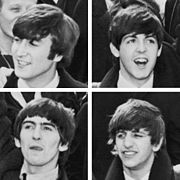
As with other large cities, Liverpool is an important cultural centre within the United Kingdom, incorporating music, performing arts, museums and art galleries, literature and nightlife amongst others. In 2008, the cultural heritage of the city was celebrated with the city holding the title of European Capital of Culture, during which time a wide range of cultural celebrations took place in the city, including Go Superlambananas! and La Princesse.
Music
Liverpool is internationally known for music and is recognised by Guinness World Records as the World Capital City of Pop. Musicians from the city have produced 56 number one singles, more than any other city in the world. Both the most successful male band and girl group in global music history have contained Liverpudlian members. Liverpool is most famous as the birthplace of The Beatles and during the 1960s was at the forefront of the Beat Music movement, which would eventually lead to British Invasion. Many notable musicians of the time originated in the city including Billy J Kramer, Cilla Black, Gerry & the Pacemakers and The Searchers. The influence of musicians from Liverpool, coupled with other cultural exploits of the time, such as the Liverpool poets, prompted American poet Allen Ginsburg to proclaim that the city was "the centre of consciousness of the human universe". Other musicians from Liverpool have included Billy Fury, A Flock of Seagulls, Echo and the Bunnymen, Frankie Goes to Hollywood, Frankie Vaughan and more recently The Zutons, Atomic Kitten and Heidi Range.
The city is also home to the oldest surviving professional symphony orchestra in the UK, the Royal Liverpool Philharmonic Orchestra, which is based in the Philharmonic Hall. The current chief conductor of the orchestra is Vasily Petrenko. Sir Edward Elgar dedicated his famous Pomp and Circumstance No.1 to the Liverpool Orchestral Society, and the piece had its first performance in the city in 1901. Among Liverpool's curiosities, the Austrian émigré Fritz Spiegl is notable. He not only became a world expert on the etymology of Scouse, but composed the music to Z-cars and the Radio 4 UK Theme.
The Mathew Street Festival is an annual street festival that is one of the most important musical events in Liverpool's calendar. The dance music festival Creamfields was established by the famous Liverpool-based Cream clubbing brand which started life as a weekly event at Nation nighclub. and There are numerous music venues located acrsoss the city, however the Echo Arena is by far the largest. Opened in 2008 the 11,000-seater arena hosted the MTV Europe Music Awards the same year and since then has held host to world renound ats such as Andrea Bocelli, Beyoncé, Elton John, Kanye West, Kasabian, The Killers, Lady Gaga, Oasis, Pink, Rihanna, UB40.
Visual arts
Liverpool has more galleries and national museums than any other city in the United Kingdom apart from London. National Museums Liverpool is the only English national collection based wholly outside London. The Tate Liverpool gallery houses the modern art collection of the Tate in the North of England and was, until the opening of Tate Modern, the largest exhibition space dedicated to modern art in the United Kingdom. The FACT centre hosts touring multimedia exhibitions, while the Walker Art Gallery houses an extensive collection of Pre-Raphaelites. Sudley House contains another major collection of pre 20th century art, and the number of galleries continues to expand: Ceri Hand Gallery opened in 2008, exhibiting primarily contemporary art, and Liverpool University's Victoria Building was re-opened as a public art gallery and museum to display the University's artwork and historical collections which include the second-largest display of art by Audubon outside the US
Artists have also come from the city, including painter George Stubbs who was born in Liverpool in 1724.
The Liverpool Biennial festival of arts runs from mid-September to late November and comprises three main sections; the International, The Independents and New Contemporaries although fringe events are timed to coincide. It was during the 2004 festival that Yoko Ono's work "My mother is beautiful" caused widespread public protest when photographs of a naked woman's pubic area were exhibited on the main shopping street. Despite protests the work remained in place.
Literature
A number of notable authors have visited Liverpool including Daniel Defoe, Washington Irving, Thomas De Quincey, Herman Melville, Nathaniel Hawthorne, Charles Dickens, Gerald Manley Hopkins and Hugh Walpole all of whom spent extended periods in the city. Hawthorne was stationed in Liverpool as United States consul between 1853 and 1856. Although he is not known to have ever visited Liverpool, Jung famously had a vivid dream of the city which he analysed in one of his works.
During the late 1960s the city became well-known for the Liverpool poets, who include Roger McGough and the late Adrian Henri. An anthology of poems, The Mersey Sound, written by Henri, McGough and Brian Patten, has sold over 500,000 copies since first being published in 1967.
June Bhatia, who writes under the name Helen Forrester, has published many novels about Liverpool, as well as her autobiography Twopence to Cross the Mersey, and its three sequels.
Performing Arts
Liverpool also has a history of performing arts, reflected in several annual theatre festivals such as the Liverpool Shakespeare Festival which takes place inside Liverpool Cathedral and in the adjacent historic St James' Gardens every summer, The Everyword Festival of new theatre writing, the only one of its kind in the country, Physical Fest, an international festival of physical theatre, organised by Tmesis, the annual festivals run by John Moores University Drama department and LIPA, and by the number of theatres in the city. These include the Empire, Everyman, Liverpool Playhouse, Neptune, Royal Court and Unity theatres. The Everyman and Playhouse are now both part of one company, and both houses produce their own work as well as receiving touring productions. The Everyman is due to be rebuilt, with the current building demolished in 2011 and a new venue on the same site planned for a 2013 opening.
Education
In Liverpool primary and secondary education is available in various forms supported by the state including secular, Church of England, Jewish, and Roman Catholic. Islamic education is available at primary level, but there is currently no secondary provision. One of Liverpool's important early schools was The Liverpool Blue Coat School; founded in 1708 as a charitable school.
The Liverpool Blue Coat School is the top-performing school in the city with 100% 5 or more A*-C grades at GCSE resulting in the 30th best GCSE results in the country and an average point score per student of 1087.4 in A/AS levels. Other notable schools include Liverpool College founded in 1840 Merchant Taylors' School founded in 1620. Another of Liverpool's notable senior schools is St. Edward's College situated in the West Derby area of the city. Historic grammar schools, such as the Liverpool Institute High School & Liverpool Collegiate, closed in the 1980s are still remembered as centres of academic excellence. Bellerive Catholic College is the city's top performing non selective school, based upon GCSE results in 2007.
Liverpool has three universities: the University of Liverpool, Liverpool John Moores University and Liverpool Hope University. Edge Hill University, originally founded as a teacher-training college in the Edge Hill district of Liverpool, is now located in Ormskirk in South-West Lancashire. Liverpool is also home to the Liverpool Institute for Performing Arts (LIPA).
The University of Liverpool, was established in 1881 as University College Liverpool. In 1884, became part of the federal Victoria University. Following a Royal Charter and Act of Parliament in 1903, it became an independent university, the University of Liverpool, with the right to confer its own degrees. It was the first university to offer degrees in biochemistry, architecture, civic design, veterinary science, oceanography and social science.
Liverpool Hope University, founded in 1844, is situated on both sides of Taggart Avenue in Childwall and a second Campus in the City Centre (The Cornerstone). Hope is quickly making a name for itself within the Liberal Arts, the University has also enjoyed successes in terms of high graduate employability, campus development, and a substantial increase in student applications from outside of the City.
The Liverpool School of Tropical Medicine, founded to address some of the problems created by trade, continues today as a post-graduate school affiliated with the University of Liverpool and is one of only two institutions internationally that house the de facto standard anti-venom repository.
Liverpool John Moores University was previously a polytechnic, and gained status in 1992. It is named in honour of Sir John Moores, one of the founders of the Littlewoods football pools and retail group, who was a major benefactor. The institution was previously owned and run by Liverpool City Council.
The city has one further education college, Liverpool Community College. Liverpool City Council operates Burton Manor, a residential adult education college in nearby Burton, on the Wirral Peninsula.
There are two Jewish schools in Liverpool, both belonging to the King David Foundation. King David School, Liverpool is the High School and the King David Primary School. There is also a King David Kindergarten, featured in the community centre of Harold House. These schools are all run by the King David Foundation based in Harold House in Childwall; conveniently next door to the Childwall Synagogue
Sport
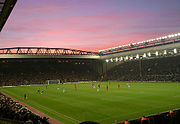
Liverpool is home to the Premier League football clubs Everton and Liverpool F.C. Liverpool is the only English city to have staged top division football every single season since the formation of the Football League in 1888, and both of the city's clubs play in high-capacity stadiums.
Everton are the older of Liverpool's two professional football clubs. They were founded in 1878 and have played at Goodison Park since 1892, when they relocated from the Anfield stadium that was taken over by the new Liverpool club. Everton have been league champions nine times, FA Cup winners five times and European Cup Winners' Cup winners once. Their most successful managers were Harry Catterick and Howard Kendall. Many high profile players have worn the Everton shirt. These include Dixie Dean (who scored a record 60 goals in a single league season), Tommy Lawton, Brian Labone, Ray Wilson, Alan Ball (who both featured in England's World Cup winning side of 1966), Neville Southall, Andy Gray, Gary Lineker, Andrei Kanchelskis, Dave Watson and Wayne Rooney.
Liverpool F.C. are one of the most successful teams in English football, having won 18 league titles, seven FA Cups, seven League Cups, five European Cups and three UEFA Cups. They formed in 1892 and have spent their entire history at the Anfield stadium which they occupied on their formation; it had previously been home to Everton. Liverpool have been in the top flight of English football continuously since 1962 and have been managed by Bill Shankly, Bob Paisley, Joe Fagan, Kenny Dalglish (who also played for the club and for a while was player-manager), Gerard Houllier, Rafael Benítez and Roy Hodgson. Famous Liverpool players include Billy Liddell, Ian St. John, Roger Hunt, Ron Yeats, Emlyn Hughes, Kevin Keegan, Ian Rush, Graeme Souness, Robbie Fowler and Steven Gerrard. However, the club also has an association with tragedy; in 1985, rioting on the terraces during the European Cup final at Heysel Stadium in Brussels, Belgium, resulted in the death of 39 spectators (almost all of them Juventus supporters) and led to all English clubs being barred from European competitions for the next five years (with Liverpool having to serve an extra year when all other English clubs were re-admitted). Four years later, 94 Liverpool fans (the toll eventually reached 96) were crushed to death at Hillsborough Stadium in Sheffield at the FA Cup semi-final. This tragedy led to the Taylor Report which saw standing accommodation banned from all top division stadiums by the mid-1990s.
Since the turn of the 21st century, both Liverpool-based clubs have been considering relocation to new stadiums. Liverpool have been planning a new stadium on nearby Stanley Park for some years, while Everton are currently investigating the possibility of a new stadium in Kirkby after an earlier project to relocate to King's Dock fell through due to financial difficulties.
Professional basketball came to the city in 2007 with the entry of Everton Tigers, now known as Mersey Tigers, into the elite British Basketball League. The club was originally associated with Everton F.C., and was part of the Toxteth Tigers youth development programme, which reached over 1,500 young people every year. The Tigers began play in Britain's top league for the 2007–08 season, playing at the Greenbank Sports Academy before moving into the newly completed Echo Arena during that season. After the 2009–10 season, Everton F.C. withdrew funding from the Tigers, who then changed their name to Mersey Tigers. Their closest professional rivals are the Chester Jets, based 18 miles (29 km) away in Chester.
County cricket is occasionally played in Liverpool, with Lancashire County Cricket Club typically playing one match every year at Liverpool Cricket Club, Aigburth.
Aintree Racecourse to the north of Liverpool in the adjacent borough of Sefton is home to the famous steeplechase, the Grand National, One of the most famous events in the international horse racing calendar, it is held in early April each year. In addition to horse-racing, Aintree has also hosted motor racing, including the British Grand Prix in the 1950s and 1960s.
Liverpool Harriers, who meet at Wavertree Athletics Centre, are one of five athletic clubs. Liverpool has a long history of boxing that has produced John Conteh, Alan Rudkin and Paul Hodkinson and hosts high level amateur boxing events. Park Road Gymnastics Centre provides training to a high level. The City of Liverpool Swimming Club has been National Speedo League Champions 8 out of the last 11 years. Liverpool Tennis Development Programme based at Wavertree Tennis Centre is one of the largest in the UK. Liverpool is also home to the Red Triangle Karate Club, which provided many of the 1990 squad that won the World Shotokan Championships in Sunderland. Luminaries include Sensei Keinosuke Enoeda, Sensei Frank Brennan, Sensei Omry Weiss, Sensei Dekel Kerer, Sensei Andy Sherry and Sensei Terry O'Neill, who is also famous for various acting roles.
Rugby league is played at amateur and student level within the city; the last professional team bearing the city's name was Liverpool City, which folded in the 1960s. Rugby union has a long, if low key, history in the city with Liverpool Football Club, formed in 1857, making them the oldest open rugby team in the world. They merged with St Helens RUFC in 1986 to form Liverpool St Helens. In Sefton there is Waterloo Rugby Club located in Blundellsands. Established in 1882, they now play in National League 2 North.
Liverpool is one of three cities which still host the traditional sport of British baseball and it hosts the annual England-Wales international match every two years, alternating with Cardiff and Newport. Liverpool Trojans are the oldest existing baseball club in the UK.
The Royal Liverpool Golf Club, situated in the nearby town of Hoylake on the Wirral Peninsula, has hosted The Open Championship on a number of occasions, most recently in 2008. It also hosted the Walker Cup in 1983.
Sports stadia
Liverpool have played at Anfield since 1892, when the club was formed to occupy the stadium following Everton's departure due to a dispute with their landlord. Liverpool are still playing there 116 years later, although the ground has been completely rebuilt since the 1970s and only the Main Stand survives from before 1992. The Spion Kop (rebuilt as an all-seater stand in 1994/1995) was the most famous part of the ground, gaining cult status across the world due to the songs and celebrations of the many fans who packed onto its terraces. Anfield is classified as a 4 Star UEFA Elite Stadium with capacity for 45,000 spectators in comfort, and is a distinctive landmark in an area filled with smaller and older buildings. Liverpool club also has a multi-million dollar youth training facility called The Academy.
After leaving Anfield in 1892, Everton moved to Goodison Park on the opposite side of Stanley Park. Goodison Park was the first major football stadium built in England. Molineux (Wolves' ground) had been opened three years earlier but was still relatively undeveloped. St. James's Park, Newcastle, opened in 1892, was little more than a field. Only Scotland had more advanced grounds. Rangers opened Ibrox in 1887, while Celtic Park was officially inaugurated at the same time as Goodison Park. Everton performed a miraculous transformation at Mere Green, spending up to £3000 on laying out the ground and erecting stands on three sides. For £552 Mr. Barton prepared the land at 4½d a square yard. Kelly Brothers of Walton built two uncovered stands each for 4,000 people, and a covered stand seating 3,000, at a total cost of £1,460. Outside, hoardings cost a further £150, gates and sheds cost £132 10s and 12 turnstiles added another £7 15s to the bill.
The ground was immediately renamed Goodison Park and proudly opened on 24 August 1892, by Lord Kinnaird and Frederick Wall of the FA. But instead of a match the 12,000 crowd saw a short athletics meeting followed by a selection of music and a fireworks display. Everton's first game there was on 2 September 1892 when they beat Bolton 4–2. It now has the capacity for more than 40,000 spectators all-seated, but the last expansion took place in 1994 when a new goal-end stand gave the stadium an all-seater capacity. The Main Stand dates back to the 1970s, while the other two stands are refurbished pre-Second World War structures.
There are currently plans for both stadiums to be pulled down and for the teams to relocate. Liverpool have been considering a move to a new stadium in Stanley Park since 2000; seven years on work has started and the 60,000-seat stadium is expected to be ready by 2014.
Everton have been considering relocation since 1996, and in 2003 were forced to scrap plans for a 55,000-seat stadium at King's Dock due to financial reasons. The latest plan has been to move beyond Liverpool's council boundary to Kirkby, but this has proved controversial with some fans, as well as members of the local community. At one point there was much talk for Everton to ground-share with Liverpool, at the proposed new stadium in Stanley Park, but this was not progressed by either club.
Notable people
Quotes about Liverpool
- "Lyrpole, alias Lyverpoole, a pavid towne, hath but a chapel... The king hath a castelet there, and the Earl of Darbe hath a stone howse there. Irisch merchants cum much thither, as to a good haven... At Lyrpole is smaul custom payed, that causith marchantes to resorte thither. Good marchandis at Lyrpole, and much Irish yarrn that Manchester men do buy there..." – John Leland (antiquary), Itinery, c. 1536–39
- "Liverpoole is one of the wonders of Britain... In a word, there is no town in England, London excepted, that can equal [it] for the fineness of the streets, and the beauty of the buildings." Daniel Defoe – A tour thro' the Whole Island of Great Britain, 1721–26
- "[O]ne of the neatest, best towns I have seen in England." – John Wesley. Journal, 1755
- "I have not come here to be insulted by a set of wretches, every brick in whose infernal town is cemented with an African's blood." Actor George Frederick Cooke (1756–1812) responding to being hissed when he came on stage drunk during a visit to Liverpool.
- "That immense City which stands like another Venice upon the water...where there are riches overflowing and every thing which can delight a man who wishes to see the prosperity of a great community and a great empire... This quondam village, now fit to be the proud capital of any empire in the world, has started up like an enchanted palace even in the memory of living men." Thomas Erskine, 1st Baron Erskine, 1791
- "I have heard of the greatness of Liverpool but the reality far surpasses my expectation" – Prince Albert, speech, 1846
- "Liverpool…has become a wonder of the world. It is the New York of Europe, a world city rather than merely British provincial.” – Illustrated London News, 15 May 1886
- "Liverpool is the 'pool of life' " – C.G. Jung, Memories, Dreams, Reflections, 1928
- "The centre is imposing, dignified and darkish, like a city in a rather gloomy Victorian novel...We had now arrived in the heart of the big city, and as usual it was almost a heart of darkness. But it looked like a big city, there was no denying that. Here, emphatically, was the English seaport second only to London. The very weight of stone emphasised that fact. And even if the sun never seems to properly rise over it, I like a big city to proclaim itself a big city at once..." – J.B. Priestley, English Journey, 1934
- "...if Liverpool can get into top gear again there is no limit to the city's potential. The scale and resilience of the buildings and people is amazing – it is a world city, far more so than London and Manchester. It doesn't feel like anywhere else in Lancashire: comparisons always end up overseas – Dublin, or Boston, or Hamburg." – Ian Nairn, Britain's Changing Towns, 1967
International links
Twin cities
Liverpool is twinned with the following cities:
| Country | Place | County / District / Region / State | Date | |||
|---|---|---|---|---|---|---|
| Germany | Cologne | North Rhine-Westphalia | 1952 | |||
| Republic of Ireland | Dublin | Leinster | 1997 | |||
| China | Shanghai | Shanghai Municipality | 1999 |
Other links
Liverpool also has links with the following cities:
 New York, US – Freedom of the City of Liverpool – August 2003
New York, US – Freedom of the City of Liverpool – August 2003 Riga, Latvia – Letter of Intent signed – March 2003
Riga, Latvia – Letter of Intent signed – March 2003 Stavanger, Norway – Letter of Intent signed – June 2004
Stavanger, Norway – Letter of Intent signed – June 2004





















